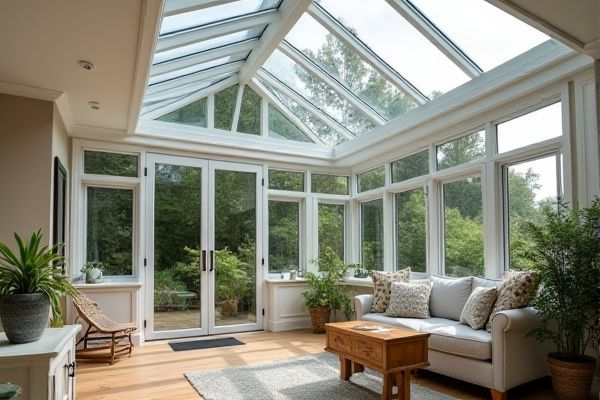
A sunroom glass roof floods your space with natural light, creating a bright and airy atmosphere, while a solid roof offers better insulation and protection from weather elements, ensuring year-round comfort. Explore the rest of the article to discover which option best suits your needs and enhances your home's value.
Table of Comparison
| Feature | Sunroom Glass Roof | Solid Roof |
|---|---|---|
| Natural Light | Maximum daylight, brightens space | Limited daylight, relies on artificial lighting |
| Insulation | Moderate insulation, may require double glazing | Excellent insulation, reduces heat loss |
| Energy Efficiency | Potential heat gain in summer, heat loss in winter | Better energy retention, consistent indoor temperature |
| Durability | Depends on glass type; tempered or laminated preferred | High durability; materials include metal, tiles, or shingles |
| Soundproofing | Limited; glass transmits noise | Superior noise reduction |
| Cost | Generally higher upfront cost | Typically lower initial cost |
| Maintenance | Requires regular cleaning to prevent dirt buildup | Low maintenance |
| Aesthetic Appeal | Modern, open, and airy look | Traditional, solid appearance |
| Weather Impact | Susceptible to temperature fluctuations and leaks if not sealed well | Strong weather resistance, better protection |
Introduction to Sunroom Roof Options
Sunroom roof options primarily include glass roofs and solid roofs, each offering distinct benefits and design impacts. A glass roof maximizes natural light, creating a bright, open atmosphere while providing insulation with modern, energy-efficient glazing. Your choice depends on factors like climate, privacy needs, and how much sunlight you want to filter into your sunroom.
What Is a Glass Roof Sunroom?
A glass roof sunroom features a transparent or translucent roof made from tempered glass or polycarbonate panels, allowing abundant natural light to flood your space while providing panoramic outdoor views. Unlike solid roof sunrooms, which use opaque materials like shingles or metal and offer better insulation and privacy, glass roofs emphasize brightness and a seamless connection to the sky. Choosing a glass roof sunroom enhances your living area with a bright, open atmosphere ideal for enjoying natural daylight year-round.
What Is a Solid Roof Sunroom?
A solid roof sunroom features a fully opaque roof made from durable materials like asphalt shingles, metal, or tiles, providing superior insulation and protection from weather elements. Unlike sunroom glass roofs that maximize natural light, solid roofs offer enhanced privacy, improved energy efficiency, and reduced noise levels. This type of sunroom is ideal for homeowners seeking comfort and versatility while maintaining the structural integrity of the living space.
Natural Light: Glass vs. Solid Roof
A sunroom glass roof allows maximum natural light to flood your space, creating a bright and airy atmosphere ideal for plant growth and enhancing mood. In contrast, a solid roof blocks sunlight, providing better insulation and privacy but limiting the amount of natural light entering the room. Choosing between the two depends on your preference for sunlight exposure versus thermal comfort and privacy.
Energy Efficiency Comparison
Sunroom glass roofs offer natural light influx but often result in higher heat loss during winter and excessive heat gain in summer, impacting energy efficiency negatively compared to solid roofs. Solid roofs provide superior insulation with materials like insulated panels or shingles, reducing energy consumption for heating and cooling. Energy-efficient sunrooms often combine glass with insulated roofing systems or use double- or triple-glazed glass to improve thermal performance.
Insulation and Temperature Control
Sunroom glass roofs offer abundant natural light but generally provide less insulation compared to solid roofs, leading to greater temperature fluctuations. Solid roofs excel in temperature control by effectively reducing heat loss in winter and minimizing heat gain in summer, enhancing energy efficiency and comfort. Choosing the right roof depends on your preference for light versus thermal regulation in your sunroom.
Aesthetic Appeal and Design Flexibility
Sunroom glass roofs offer unparalleled aesthetic appeal by allowing natural light to flood the space, creating a bright and airy atmosphere that visually connects indoor and outdoor environments. In contrast, solid roofs provide greater design flexibility with options for insulation and weather protection, enabling a cozier and more energy-efficient space tailored to various climate needs. Both roofing types can be customized with materials and finishes to complement architectural styles, balancing beauty and functionality.
Maintenance and Durability Factors
Sunroom glass roofs require regular cleaning to prevent dirt buildup and potential damage from weather exposure, while solid roofs demand less frequent maintenance but may need periodic inspections for leaks or structural integrity. Glass roofs are typically more susceptible to cracks and seal deterioration, especially in extreme climates, whereas solid roofs offer enhanced durability against heavy rain, snow, and wind. Your choice between a glass or solid sunroom roof should consider long-term maintenance efforts and how each material withstands your local weather conditions.
Cost Differences and Installation
Sunroom glass roofs typically cost more than solid roofs due to the higher price of tempered or laminated glass and specialized framing materials designed to support weight and provide weather resistance. Installation of glass roofs requires skilled professionals experienced in handling heavy glass panels and waterproof sealing to prevent leaks, often resulting in longer labor hours compared to solid roof construction. Solid roofs, made from materials like asphalt shingles or metal panels, offer simpler, faster installations and lower overall costs, making them a budget-friendly option for sunroom enclosures.
Which Sunroom Roof Is Best for You?
Choosing between a sunroom glass roof and a solid roof depends on your preferences for natural light, energy efficiency, and privacy. A glass roof maximizes sunlight, creating a bright, open atmosphere ideal for enjoying outdoor views year-round, while a solid roof offers better insulation and privacy, making it more energy-efficient and comfortable during extreme weather. Your decision should balance aesthetic appeal with practical needs like temperature control and privacy to find the sunroom roof that best suits your lifestyle.
 homyna.com
homyna.com